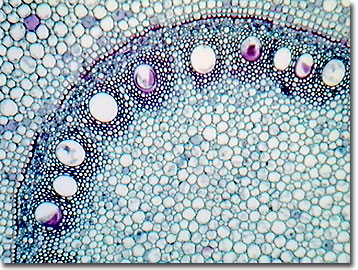Brightfield Digital Image Gallery
Corn Root Tissue
Corn is the common name for the cereal grass widely grown as food for humans and animals. Along with wheat and rice, it is one of the world's chief grain crops and the leading crop grown in the United States. Native to the Americas, corn (Zea mays), the domesticated variety of the Zea grass family, originally was cultivated by Native Americans 8,000 to 10,000 years ago and is now used for human food and animal feed.

View a high magnification image of corn root tissue.
Corn plants have an erect, solid stem, rather than the hollow stem characteristic of most other grasses. As monocots, corn and palms do not create concentric annual rings. Rather, they are characterized by scattered vascular bundles composed of xylem and phloem tissue, with each bundle surrounded by a bundle sheath. The corn plants vary widely in height, from 2 feet (61 centimeters) to 18 feet (5.5 meters), depending on the variety. The plants have long narrow leaves that grow alternately along the length of the stalk. Each stalk terminates with a tassel bearing tiny flowers that produce pollen, the male gamete. The ear, covered by modified leaves called husks, is the pistillate (female) part of the plant and bears up to 1,000 seeds. A cluster of silk fibers protrudes from the tip of the ear, each fiber attached to an individual ovary. Pollen from the tassels is carried by the wind and falls onto the silks. There, it germinates and grows down through the silk until it reaches the ovules, each of which develops into a kernel of corn.
An early maturing hybrid may develop fewer leaves or progress to different stages at a faster rate than wild maize. In contrast, a late maturing hybrid may develop more leaves or progress more slowly. Like a community of thousands of highly organized and highly efficient "factories" per acre of cultivated land, the cornfield, fueled by solar power, converts the raw materials of water, minerals, and atmospheric gases into combinations of proteins, oils, carbohydrates, and mineral nutrients. Agronomists usually break the life cycle of a corn cultivar into several vegetative and reproductive stages, with each leaf stage defined by the uppermost leaf.
Contributing Authors
Cynthia D. Kelly, Thomas J. Fellers and Michael W. Davidson - National High Magnetic Field Laboratory, 1800 East Paul Dirac Dr., The Florida State University, Tallahassee, Florida, 32310.
BACK TO THE BRIGHTFIELD IMAGE GALLERY
BACK TO THE DIGITAL IMAGE GALLERIES
Questions or comments? Send us an email.
© 1995-2025 by Michael W. Davidson and The Florida State University. All Rights Reserved. No images, graphics, software, scripts, or applets may be reproduced or used in any manner without permission from the copyright holders. Use of this website means you agree to all of the Legal Terms and Conditions set forth by the owners.
This website is maintained by our
Graphics & Web Programming Team
in collaboration with Optical Microscopy at the
National High Magnetic Field Laboratory.
Last Modification Friday, Nov 13, 2015 at 01:19 PM
Access Count Since September 17, 2002: 21052
Visit the website of our partner in introductory microscopy education:
|
|
